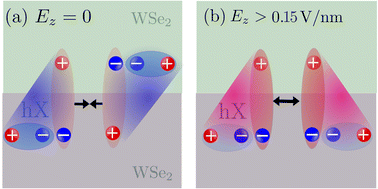Electrically tunable dipolar interactions between layer-hybridized excitons†
Abstract
Transition-metal dichalcogenide bilayers exhibit a rich exciton landscape including layer-hybridized excitons, i.e. excitons which are of partly intra- and interlayer nature. In this work, we study hybrid exciton–exciton interactions in naturally stacked WSe2 homobilayers. In these materials, the exciton landscape is electrically tunable such that the low-energy states can be rendered more or less interlayer-like depending on the strength of the external electric field. Based on a microscopic and material-specific many-particle theory, we reveal two intriguing interaction regimes: a low-dipole regime at small electric fields and a high-dipole regime at larger fields, involving interactions between hybrid excitons with a substantially different intra- and interlayer composition in the two regimes. While the low-dipole regime is characterized by weak inter-excitonic interactions between intralayer-like excitons, the high-dipole regime involves mostly interlayer-like excitons which display a strong dipole–dipole repulsion and give rise to large spectral blue-shifts and a highly anomalous diffusion. Overall, our microscopic study sheds light on the remarkable electrical tunability of hybrid exciton–exciton interactions in atomically thin semiconductors and can guide future experimental studies in this growing field of research.



 Please wait while we load your content...
Please wait while we load your content...